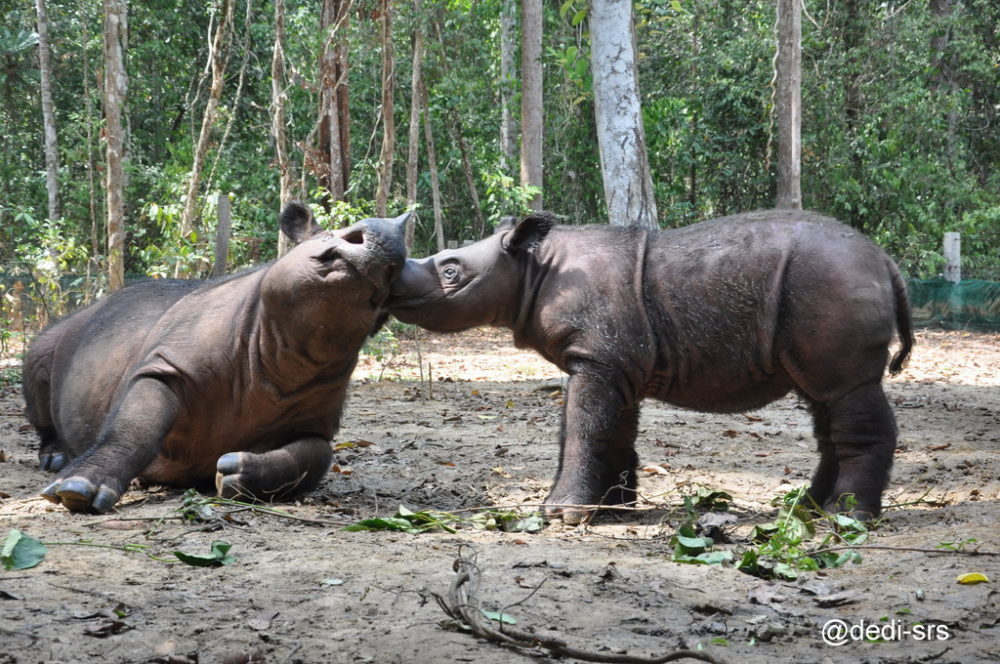Written by Susie Ellis, Executive Director at the International Rhino Foundation, USA.
Sex. Good, old-fashioned S-E-X. More than 29,000 rhinos and 7.6 billion people walk the Earth because of it. Sex works, right? Parents’ nightmares of teenagers aside, one of the most basic instincts for all species is to reproduce.
Yet, despite their innate drive to have young, some rhino species are notoriously difficult to breed, especially in managed settings. Sumatran rhinos, in particular, have presented captive managers with a steep learning curve. The species has been held in captivity since the mid-1980s but, because of a number of factors, breeding was not successful until 2001, when the Cincinnati Zoo and Botanical Gardens produced a calf. Under International Rhino Foundation Board Member, Dr Terri Roth’s leadership, Cincinnati subsequently produced three more calves; two males and a female. Unfortunately, the parents and the female calf died of natural causes. Both males were later moved to the Sumatran Rhino Sanctuary in Indonesia, where one has become a father and one is trying to be a dad with all his heart (and body).
Did you know
80%
Sumatran rhinos have declined in the wild by 80% in the past 20 years
It’s no secret – the key to successful reproduction is getting males and the females together at precisely the right time. For Sumatran rhinos, this is a 2-day window when a female’s ovarian follicle reaches 18-20 mm in diameter. Using methods perfected by Dr Roth and colleagues, the Sumatran Rhino Sanctuary’s veterinarians monitor each female’s follicular development. When the time is right, they put her with a male. So far, this tried-and-true method has seen two calves produced at the SRS: a male, Andatu in 2012 (above), and a female, Delilah, in 2016.
So what about reproduction by artificial means? Following the death of Sudan, the last male Northern white rhino, in March 2018, the issue of Advanced Reproductive Techniques (ARTs) to save rhino species has once again become a hot topic. Despite an undocumented (but large) number of procedures conducted during the course of 20+ years, fewer than 10 live rhino births have resulted from artificial insemination, and these only in the white and Greater one-horned rhino species. Just a handful of rhino embryos have ever been created: one grew to two cells, the other to three cells, and at least one, from a Northern white rhino and Southern white rhino, has recently been developed to the blastocyst stage in vitro.
It is possible that ARTs could help the Sumatran rhino further down the road. To preserve all options, and with thanks to training by the San Diego Institute for Conservation Research, the Sumatran Rhino Sanctuary has also cryo-preserved fibroblasts (the precursor for stem cells). But the technology, which could help to slightly increase numbers, will likely not be in place in time given the rate of decline.
To-date, no species has been saved by ‘high-tech’ approaches alone. But when integrated with natural breeding and protection of wild populations, such technologies have proven valuable. We need to tackle the challenges facing Sumatran rhinos using multi-faceted approaches, keeping the door open for high-tech’ science while also using the tried-and-true methods. We applaud the advances and the exploratory value of advanced reproductive technology for future rhino conservation efforts, including with the Northern white rhinos.
For Sumatran rhinos, for now, we’ll take good, old-fashioned S-E-X. More please!
This article was originally printed in The Horn 2018.








